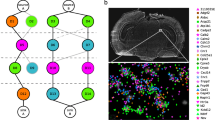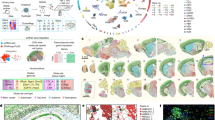Abstract
Voxelation allows high-throughput acquisition of three-dimensional gene expression patterns in the brain through analysis of spatially registered voxels (cubes). The method results in multiple volumetric maps of gene expression analogous to the images reconstructed in biomedical imaging techniques. An important issue for voxelation is the development of approaches to anchor correctly harvested voxels to the underlying anatomy. Here, we describe experiments to identify fixation and cryopreservation protocols for improved registration of harvested voxels with neuroanatomical structures. Paraformaldehyde fixation greatly reduced RNA recovery as judged by ribosomal RNA abundance. However, gene expression signals from paraformaldehyde-fixed samples were not appreciably diminished as judged by average signal–noise ratios from microarrays, highlighting the difficulties of accurate quantitation of cross-linked RNA. Additional use of cryoprotection helped to improve further RNA recovery and signal from fixed tissue. It appears that the best protocol to provide the necessary resolution of neuroanatomical information in voxelation entails a controlled dose of fixation and thorough cryoprotection, complemented by histological staining.
Similar content being viewed by others
References
Liu, D. and Smith, D. J. 2003. Voxelation and gene expression tomography for the acquisition of 3-D gene expression maps in the brain. Methods 31:317–325.
Singh, R. P. and Smith, D. J. 2003. Genome scale mapping of brain gene expression. Biol. Psychiatry 53:1069–1074.
Brown, V. M., Ossadtchi, A., Khan, A. H., Yee, S., Lacan, G., Melega, W. P., Cherry, S. R., Leahy, R. M., and Smith, D. J. 2002. Multiplex three-dimensional brain gene expression mapping in a mouse model of Parkinson's disease. Genome Res. 12:868–884.
Brown, V. M., Ossadtchi, A., Khan, A. H., Cherry, S. R., Leahy, R. M., and Smith, D. J. 2002. High-throughput imaging of brain gene expression. Genome Res. 12:244–254.
Ossadtchi, A., Brown, V. M., Khan, A. H., Cherry, S. R., Nichols, T. E., Leahy, R. M., and Smith, D. J. 2002. Statistical analysis of multiplex brain gene expression images. Neurochem. Res. 27:1113–1121.
Singh, R. P., Brown, V. M., Chaudhari, A., Khan, A. H., Ossadtchi, A., Sforza, D. M., Meadors, A. K., Cherry, S. R., Leahy, R. M., and Smith, D. J. 2003. High-resolution voxelation mapping of human and rodent brain gene expression. J. Neurosci. Methods 125:93–101.
Annese, J. and Toga, W. A. 2002. Postmortem anatomy. Pages 537–571, in Toga, A. W. and Mazziotta, J. C. (eds.), Brain mapping: the methods, Academic Press, New York.
Rosene, D. L. and Rhodes, K. J. 1990. Cryoprotection and freezing methods to control ice crystal artifact in frozen sections of fixed and unfixed brain tissue. Pages 360–390, in Conn, P. M. (ed.), Quantitative and qualitative microscopy, Academic Press, New York.
Hegde, P., Qi, R., Abernathy, K., Gay, C., Dharap, S., Gaspard, R., Hughes, J. E., Snesrud, E., Lee, N., and Quackenbush, J. 2000. A concise guide to cDNA microarray analysis. Biotechniques 29:548–562.
Harrison, P. J., Heath, P. R., Eastwood, S. L., Burnet, P. W., McDonald, B., and Pearson, R. C. 1995. The relative importance of premortem acidosis and postmortem interval for human brain gene expression studies: selective mRNA vulnerability and comparison with their encoded proteins. Neurosci. Lett. 200:151–154.
Goss, J. R., Finch, C. E., and Morgan, D. G. 1990. GFAP RNA increases during a wasting state in old mice. Exp. Neurol. 108:266–268.
Johnson, S. A., Morgan, D. G., and Finch, C. E. 1986. Extensive postmortem stability of RNA from rat and human brain. J. Neurosci. Res. 16:267–280.
Bahn, S., Augood, S. J., Ryan, M., Standaert, D. G., Starkey, M., and Emson, P. C. 2001. Gene expression profiling in the postmortem human brain—no cause for dismay. J. Chem. Neuroanat. 22:79–94.
Parlato, R., Rosica, A., Cuccurullo, V., Mansi, L., Macchia, P., Owens, J. D., Mushinski, J. F., De Felice, M., Bonner, R. F., and Di Lauro, R. 2002. A preservation method that allows recovery of intact RNA from tissues dissected by laser capture microdissection. Anal. Biochem. 300:139–145.
Scheidl, S. J., Nilsson, S., Kalen, M., Hellstrom, M., Takemoto, M., Hakansson, J., and Lindahl, P. 2002. mRNA expression profiling of laser microbeam microdissected cells from slender embryonic structures. Am. J. Pathol. 160:801–813.
Goldsworthy, S. M., Stockton, P. S., Trempus, C. S., Foley, J. F., and Maronpot, R. R. 1999. Effects of fixation on RNA extraction and amplification from laser capture microdissected tissue. Mol. Carcinog. 25:86–91.
Van Deerlin, V. M. D., Ginsberg, S. D., Lee, V. M. Y., and Trojanowski, J. Q. 2002. The use of fixed human post mortem brain tissue to study mRNA expression in neurodegenerative diseases:applications of microdissection and mRNA amplification. Pages 201–235, in Geshwind, D. H. and Gregg, J. P. (eds.), Microarrays for the neurosciences: an essential guide, MIT Press, Boston.
Bonaventure, P., Guo, H., Tian, B., Liu, X., Bittner, A., Roland, B., Salunga, R., Ma, X. J., Kamme, F., Meurers, B., Bakker, M., Jurzak, M., Leyson, J. E., and Erlander, M. G. 2002. Nuclei and subnuclei gene expression profiling in mammalian brain. Brain Res. 943:38–47.
Author information
Authors and Affiliations
Corresponding author
Rights and permissions
About this article
Cite this article
Sforza, D.M., Annese, J., Liu, D. et al. Anatomical Methods for Voxelation of the Mammalian Brain. Neurochem Res 29, 1299–1306 (2004). https://doi.org/10.1023/B:NERE.0000023616.67996.00
Issue Date:
DOI: https://doi.org/10.1023/B:NERE.0000023616.67996.00




